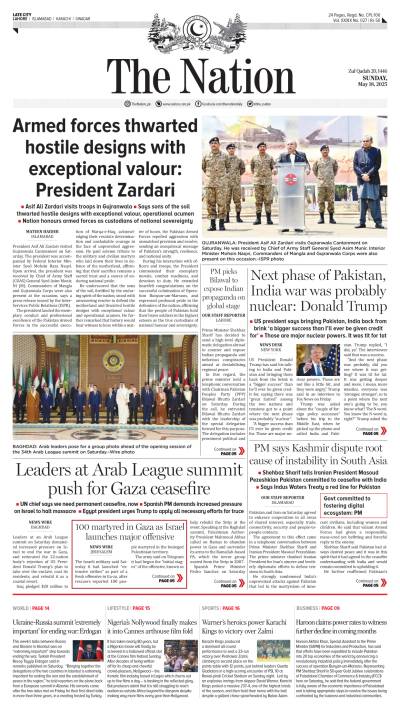The terrible anguish and pain of the near and dear ones of those who lost their lives in the Bhoja Air plane crash is still fresh in our minds. Hopefully, the enquiry by a professional team would soon bring out the causes of the mishap. Normally, the investigators confine themselves to the direct causes of an accident. However, during 36 years of my flying experience as an Air Force pilot and four years as the first Director General of the Civil Aviation Authority (CAA), I had observed that most of the accidents were the culmination of a series of blunders, mostly hidden from view. Much like the iceberg where only the tip is visible, while most of it is submerged in the water and out of sight. Therefore, to ensure better air safety standards for the future, the investigators must also look into those “hidden” or “indirect factors” that may have contributed to the unfortunate accident.
Among the “apparent causes”, one needs to look closely into the resumption of the Bhoja Airline operations after almost a suspension period of 10 years. Was it allowed under political pressure or on merit? Did it have the requisite financial soundness; adequate operational, technical and physical infrastructure; duly qualified and physically fit aircrew; and a certain minimum number of airworthy aircrafts?
Moreover, the prevailing weather conditions were reported to be gusting winds with low clouds and poor visibility. Such conditions were generally associated with severe turbulence and wind shear/downdraught, leading to sudden loss of height. It is a very dangerous situation, especially when the aircraft is flying low and slow during its approach and landing. One may recall another accident close to the Islamabad Airport some 15 months ago (Air Blue that crashed in the Margalla Hills) - also, during inclement weather. It seems that bad weather was the common denominator in both the accidents. The questions, however, remain: Why were the two aircraft not diverted by the air traffic control when the weather was apparently so bad? Did the airport radar warn the pilots of the impending danger? Having said that, it is important to add that the onus of safe air operations primarily rests with the airline concerned and the aircraft captain is the ultimate authority to take the decisions. Air traffic control, therefore, can only be a contributing factor, but not the primary cause.
Among the “hidden factors”, the most critical is the function of the CAA that has the primary responsibility to ensure safe air environments in the country. The airports and the air traffic systems are managed by the CAA. Keeping this in view, all the airlines and pilots are required to be regularly checked and cleared by it. The CAA is critical for safe air operations; its operations and airworthy branches (being directly responsible) must be manned by competent professionals.
Further, the Islamabad Airport being weather prone and lying in the heart of a built-up area is no longer safe to operate from. Fateh Jang, a much safer area weather-wise and not being in the heart of the city, is a far better location. However, the planning and development of this new airport has dragged on for years; this certainly needs to be looked into.
Another important consideration is the appointment of airport managers, especially at major airports. They should be from a cadre of air traffic controllers to ensure efficient air traffic systems in the critical area in and around the airports. And since the major airports are mostly located at the federal and provincial capitals, the airport managers at those airports are likely to be “sucked into” protocol duties and coordination matters with the civil administration.
To ensure that the airport managers do not get distracted from their primary responsibility, the concept of zonal managers was introduced at the airports in the past. Apparently, that arrangement had been done away with, burdening the airport managers with “non-operational” duties. That, too, needs to be looked into.
Yet another important consideration is the span of control of an organisation. The CAA has tremendously grown since its inception in 1982. Gone are the days when the PIA was the sole operator. Now, there are several airlines as well as general aviation entities to be dealt with. There are nearly 40 airports managed by the CAA (as compared to 22 when it was established). It has to maintain and operate an advanced air traffic system based on radar and automated control, which is the backbone of its air safety system. And, as mentioned earlier, it carries out regulatory functions, to check the airworthiness of all civil aircrafts as well as the pilots’ physical fitness and competence. All that cannot possibly be handled efficiently by a single organisation or individual at the helm.
Therefore, it is time to bifurcate the CAA into a “public sector” entity (to be called CAA) to look after air traffic and regulatory functions, while for “commercial functions” - i.e. managing the airports - a separate entity called the “Pakistan Airport Authority” may be instituted as is the case in India and elsewhere. The proposed Authority would manage all the airports on purely commercial basis. Presently, over 80 percent of the CAA’s income is based on aviation charges paid by the airlines and passengers; whereas, at airports like Frankfurt over 60 percent of its income is generated from commercial activities. By creating a separate Authority (a corporate entity), the full potential of the airports could be realised.
A third entity to be “carved out” of the CAA should be an independent Accident Investigation Board, rather than the aviation conducting the investigations; this is specifically to avoid a conflict of interest. Besides this, the dedicated body would just focus on the causes of the accidents and their preventions.
Last but not least, it is high time for the federal government to establish a separate Aviation Ministry, keeping in view the tremendous growth of this sector and the economic potential of civil aviation. Here again, it may be mentioned that India and most other countries have aviation ministries. The present arrangement of the civil aviation being part of the Defence Ministry makes little sense.
To conclude, to make Pakistan’s Aviation Industry safe, reliable and economically sound, the government should consider restructuring the CAA. And to make the investigation of accidents more thorough and reliable, one needs to look into both the “apparent” and the “hidden” causes. In the ultimate analysis, air safety is the reflection of a country’s governance and its professional culture.
The writer is a retired air marshal (First DG CAA 1982-1986).
Email: marshalmm@gmail.com
Sunday, May 18, 2025
Tip of the iceberg
DC reviews cleanliness efforts
May 18, 2025
Scorching heat in Lahore
May 18, 2025
Pak Army victory against India lauded
May 18, 2025
-
Lahore emerges among safest global cities in Numbeo 2025 index
-
Lahore emerges among safest global cities in Numbeo 2025 index
-
India’s suspension of Indus Water Treaty legally baseless
-
Seventh polio case reported in Pakistan amid nationwide vaccination drive
-
Pakistan reports sixth polio case of 2025
-
PTA begins issuing VPN licences to regulate usage
Culture Shift
May 18, 2025
Tactical Shift
May 18, 2025
Unmasked Cruelty
May 18, 2025
India Isolated
May 17, 2025
Descent into Hell
May 17, 2025
Fostering Entrepreneurship
May 18, 2025
Behind a Promising Job Offer
May 18, 2025
Indo-Pak Wisdom
May 18, 2025
Traffic Signal at Shahzad Town
May 18, 2025
English a Measure of Intelligence?
May 17, 2025
ePaper - Nawaiwaqt
Nawaiwaqt Group | Copyright © 2025





